Cognitive resistance rules and instructions

We had three teachers of mathematical analysis and analytical geometry at the university. The first read us a textbook at lectures and hate everyone. The second one argued everything himself and explained what he was doing. It was fun, because sometimes we came to a dead end and returned. The third heaped up telling tales and practical tasks for what he explained. Guess who the group average results were better.
I mean, in our world, any reading of instructions is a necessary measure. And if the user needs to read and understand something, it is better to submit information quickly, clearly and in relation to the real world.
')
I'll tell you how we simplify the understanding of the rules and instructions for board games. In general, the same set of mechanics is suitable for improving a number of interfaces, virtually any technical texts, and in general things where the mind of an architect engineer meets the mind of an exogenous user.
Step-by-step confirmation
The perfect learning game is when someone knows the rules. Because otherwise - the whole company sticks to them in half an hour. Most likely, you do not call your friends to read the instructions. But in fact, with the new game, this can happen. So let's start with the architecture of the rules.

This is how it looks for Mafia before simplification:
“The leader announces the coming of the night; everyone should close their eyes. Next, the lead announces the course of the characters in the order indicated below. The named character opens his eyes and performs actions that correspond to his roles, after which he falls asleep again.
The order of moves at night: 1. Mafia. 2. Doctor. 3. Putana. 4. Commissioner
Note: add. characters go to the queue specified in their description.
After all the characters have fulfilled their role, the master announces the coming of the morning. ”
Difficult enough, right? Now look at this block of text. It is more, but it is more understandable in terms of what to do.
“Players take turns viewing their cards, then the host announces the night. Night - this means that all players must close their eyes. On the first night, the following actions occur:
1. The mafia wakes up. All players with Mafia and Don Mafia cards open their eyes (or take off their masks). Mafia meets each other, with the leader, and gestures agree on killings for the next three nights. It takes 60 seconds. This can be done by pointing to potential victims or showing partners their number.
Mafia falls asleep (closes eyes or puts on a mask).
2. The commissioner wakes up. The Commissioner can get from the lead information about whether the player he chooses is Mafia. For this Commissioner points to the player ... "
To start playing in the first case, you need to read all the rules. You can start playing in the second one (at least in the training game) by reading the rules step by step.
First person
It's simple, the rules are read by someone specific. Therefore it is necessary to remove another barrier - a third party.

It helps to read faster, because the reader is one, and he is you.
Grouping of semantic blocks
Open the microwave manual. If you are unlucky, first you will wade through the jungle of prohibitions, and then you will find a description of each individual block and its possible states. For example, a description of what the same button does in different modes. This is the approach of an engineer who has well structured information. It is useful for reference books and engineering instructions, but it is completely unsuitable for users who are familiar with your piece for a particular application.
So we did one more thing:

That is, it is more convenient to talk first about typical scenarios such as “defrost a chicken” or “warm up pasta”, and only then do an engineering handbook for those who care about small things and details. The first grouping according to the user scenario will close 95% of the minimum requirements and will be gratefully received. Because it is simple and understandable.
For example, in the game "Boom" we do not explain why we need all the elements of the map interface, but just learn to play the first batch. The color of the lines for the players at this moment is simply decorative. Already at the end of the rules, in the FAQ, we explain that you can play by numbers (as taught earlier), or by color, so that the difficulty changes randomly. This modification of the rules is relevant in practice only after the company has played at least a couple of times.
Decomposition of difficult places
The rule: “Whoever gets the most coins wins” is enough to understand the essence of victory. Now imagine that a draw situation is rare enough, say, happens in less than a percent of cases. And then - a complicated procedure: if suddenly you and your opponent have the same coins, the following elements of comparison come into action: “Then the one who first built the lock wins. If the castles were built at the same time, then the one who has more knights in the army wins. If the knights in the army are the same, the player who went second wins. ”
Why does this need to be known to a player who has not yet encountered a coin draw? Let's put it at the end of the rules!

If you read the technical documentation, you know how sometimes the description of all unnecessary situations and unlikely functions clutters the text and makes it difficult to understand a particular block. Therefore, we have decided for ourselves - the main thing separately, the exceptions - separately.
Tongue
The liveliness of a language is an important principle of ease of understanding. Yes, yes, this is me, including the case when the plant's productivity falls due to the ban on foul language: until you explain to your colleague what is required, half a day will pass.

See how it looks in the rules of a game that has not yet been released:
“3. Now you need to choose quartermaster - the most honest pirate. It is desirable, without one leg, so as not to run away with the treasure. But if there is no such thing in your company, the most responsible one will do. He will keep the score on the laminated plate with a marker. At the beginning of the game the pirates have no gold. If you think about it, that's why they are pirates. ”
You tie each piece of knowledge to gaming reality and give specific examples at the expense of this vitality. Information is redundant, but it is this redundancy that guarantees understanding. Here is a simpler example from the engineering psychology reference book:
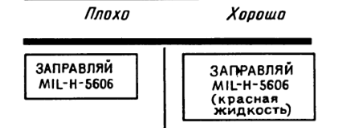
When to start
Sometimes, if a person has taken it upon himself to read the instructions, he will finish reading it to the end, although you can begin practical experiments in the middle. It is necessary to highlight the moment when you can begin to do something, referring to a piece of paper right in the rules. Because it is so clearer.

See:
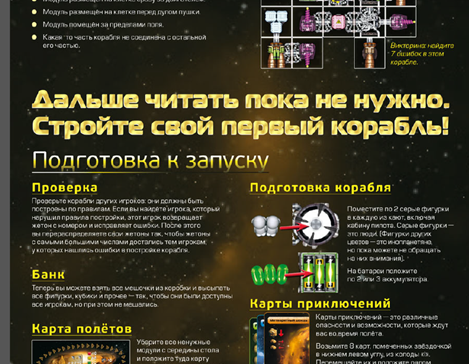
Or so:
“Karramba! Everything, now you approximately imagine a piracy life. You can start playing the first training game (in 4 islands) right now, reading the rules along the way. All real captains do just that. ”
Overview
This is laying the future of learning in a clear and simple scenario. Something like a short pseudocode describing the essence of the algorithm - and the real code goes on.

In this style, the rules usually begin:
“Mafia” is a salon team psychological step-by-step role-playing game with a detective plot that simulates the struggle of the members of an organized minority with each other who are informed about each other with an unorganized majority.
This is what we do:
About the game
Every turn you discover a new pirate island. The task is to use your action cards in such a way as to pick up a treasure before rivals. A healthy pirate in one year can visit about 12 islands - so after the tenth the party ends, and filibusters go to the tavern to count gold. Who has more coins - he won.
Hence the goal of the game - to get as many coins as possible.
Difficult - overboard!
Since our main user, who reads the instructions, is casual (even if the game is mega-hardcore, it is still almost casual, because it is played for the first time), it should be introduced gradually into the course of the game. Like learning a new programming language, first the basic syntax, then the "tricks", then the functions of the main libraries.

Here is the evolution of the rules of one of the games:

Inline examples

All, again, simple. Previously, there was only one example (if lucky) - at the end of the rules. Now there are a lot of small examples throughout the text, right next to the text. By the way, about a cat - this is what we lured children to the scientific block about potential and kinetic energy. No animal was hurt, but believe me, the learning process went much faster and more alive.
Another example
What to do if the character from the card is not familiar to you?
To begin with, try to explain it by associations, images, or try to explain a consonant word.
Example. Vladimir Red Sun can be explained as follows:
- Shone!
- The sun!
- So, the second part of the name - color!
- Green?
- Not!
- Red?
- Yes! Name - like Lenin!
- Vladimir Krasnosolntsev?
- Nearly. Remember!
- Aah, Vladimir the Red Sun!
- Right.
Example. Mine Reed can be explained like this:
“I don't know him, but his last name is similar to what they do with books.”
- Read?
- Yes. And now in English?
- Reed!
- Yes.
- Uh ... Mine Reed?
At the end of the first round, you can (and even need!) To look into the dictionary of characters and find out who the one you were so difficult to explain was.
To begin with, try to explain it by associations, images, or try to explain a consonant word.
Example. Vladimir Red Sun can be explained as follows:
- Shone!
- The sun!
- So, the second part of the name - color!
- Green?
- Not!
- Red?
- Yes! Name - like Lenin!
- Vladimir Krasnosolntsev?
- Nearly. Remember!
- Aah, Vladimir the Red Sun!
- Right.
Example. Mine Reed can be explained like this:
“I don't know him, but his last name is similar to what they do with books.”
- Read?
- Yes. And now in English?
- Reed!
- Yes.
- Uh ... Mine Reed?
At the end of the first round, you can (and even need!) To look into the dictionary of characters and find out who the one you were so difficult to explain was.
Pictures
Due to the limitations that I don’t understand, quite often the instructions are made first with text and then with pictures. And rarely anyone tries to merge these two genres. Comics works better than just “see Figure 1.” Directly in the picture can be shown and explained. That's cool.

See:
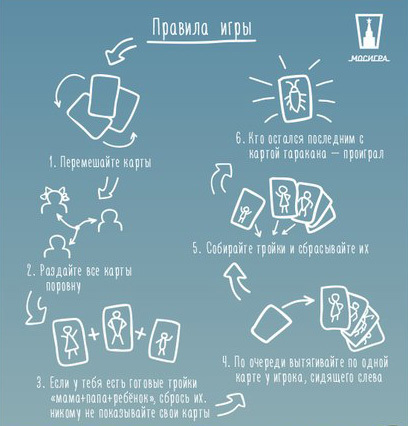
Or even cooler, as we do in the short rules on the site:
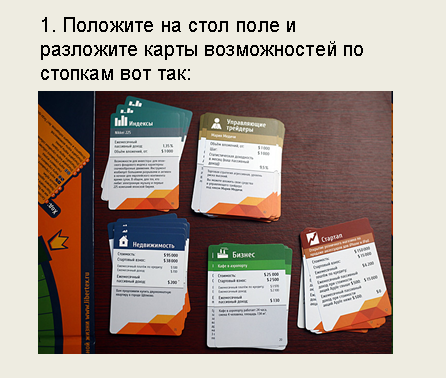
Agree, look at the picture and lay out the cards "like this" easier than reading half a page describing how to do it correctly.
Self documenting
One of the most important principles of a good interface is the absence of the need to read instructions. The puzzle is well self-documented at the physical level (unless we are a very strong player). Insert the COM-connector in the LPT will not work (although one musician hammered). To flip the train of the old hard drive is also difficult, there is a plastic ledge. It is very difficult to get the scissors wrong and so on.
Rules and instructions can and should be unloaded by putting important things on the components themselves, both at the physical level and at the reminder level.


This is the first card, then it became even easier.
Test batch
In many games, a test batch is provided, which is usually much shorter than the main game and much simpler. She is a kind of analogue of a simplified demo version from the real world, such an educational mission.
Here, look at the rules of "Space truckers":

I highlighted in green the piece that belongs to the test flight. As soon as you have passed it, everything else is already, in fact, a reference book on exceptions that clarifies and adds depth to the game.
In the same Space Alert, books are divided into two: 48 pages of basic rules and about 20 - the first flight interspersed with the plot of the game. In the printers, you could see two books - a thick official manual and a piece of “Quick Start” with basic things. Good practice.
Duplication
As it turns out on tests, important things to understand should be duplicated. For an IT person, just mentioning something is enough. For an ordinary player, no, and it is worth adding redundancy to make it easier for him.
It was:
7. Start a new move.
It became:
7. Hurray! It's time to start the next turn. Once again, it's simple:
- Discover a new island.
- Choose actions for your pirate and put them in front of you closed.
- All together, open the action and see who went where.
- Count the gold and record a new account.
- Distribute action cards: first one for each, then for those who have less than four - up to four. And immediately change the first player.
Metadata
Another good practice was adding metadata. For example, tips on tactics, adding information about when and when feedback is needed, information about where to ask a question by the rules, information about how to learn how to play the fastest, and so on.
Why is all this necessary?
We have several areas of work with such things. Firstly, we try to make our own rules for even very hardcore games more clearly. We do not change the “hardcore degree” of the game itself, but we make learning easier. Secondly, in the school of sellers, we develop short rules for the demonstration of games in the store (30 seconds for everything), which cover the main features of the game. Thirdly, we try to teach animators so that they quickly and simply convey the rules on the game stores.
And, of course, for sales. The theoretical scheme of the game distribution looks like this (this is a geometric progression):
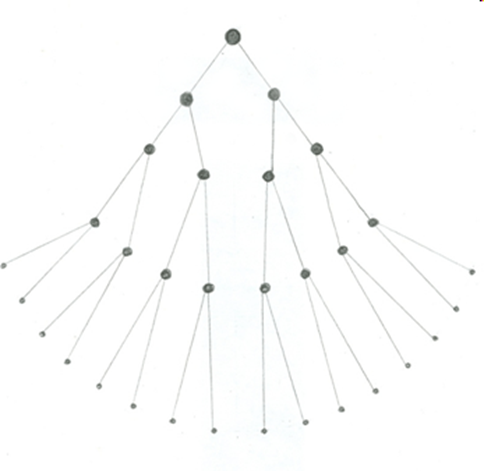
In practice, for the same microorganisms, the progression does not work. See, here is a graph of the theory of their reproduction almost in Fibonacci and in the real world:
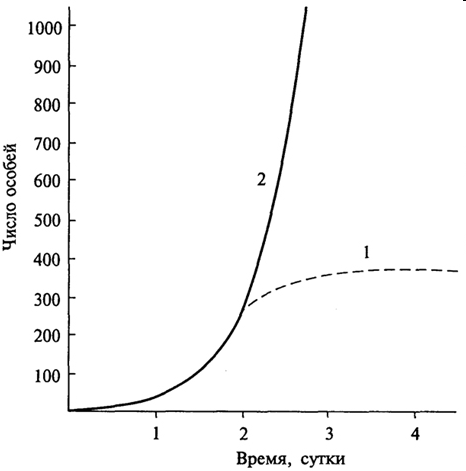
The brain likes to save energy, and when there is a choice from the good old familiar game and the new incomprehensible, he will try to incline the carrier to the already familiar one. Roughly speaking, in our case, the flatness of the dotted line of the graph depends on the entrance threshold. The simpler the game, the higher this part of the curve, and the more it spreads.
That is why we love when the game can be learned quickly.
Source: https://habr.com/ru/post/253795/
All Articles